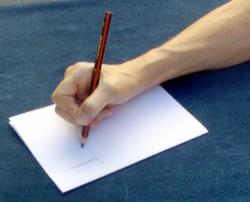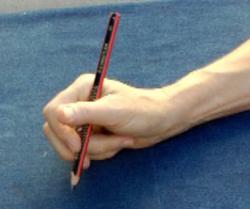What is a functional pencil grip for drawing and handwriting?
It is one that allows the child to keep the wrist straight and steady and make small movements of the wrist and fingers to move the pen tip in different directions to create short straight and curved lines.
Research has shown that an "ideal" tripod pencil grip is not needed for fluent handwriting. In fact, trying to change a functional adapted grip often creates problems for the child.
The message is: any grip that is comfortable and allows a child make small bending and straightening movements of the fingers along with very small wrist movements is acceptable.
Attempting to change a functional adapted grip into a tripod grip will often make handwriting difficult and tiring for the child. It creates a problem rather than solving one.
Development of pencil grip
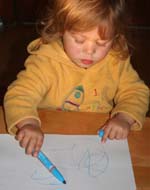



Pencil grasp and finger movements
- The pencil shaft is supported between the thumb and the middle finger and the forefinger rests on the top of the pencil shaft.
- The ring and the little finger rest lightly in the palm of the hand.


Hypermobility and grasp configuration
- The shaft pencil is supported by the thumb against the base of the forefinger and the side of the middle finger.
- The tip of the forefinger rests against the shaft of the pencil close to the tip.
- This adapted grasp still allows the child to make small bending movements of the fingers to move the pencil tip.

Take time to observe finger movements for drawing short lines
Try the following Position your arm vertically on the page. Now draw a short up and down lines. You will probably notice that to draw these short lines you are bending and extending the fingers while the thumb stays straight. Now draw several short back-and-forth horizontal lines. Notice that this time you probably using small wrist movement to produce the lines.
When does a grasp configuration need to be changed?
The important thing to pay attention to when assessing a child's grip is not whether it conforms to some ideal but rather whether the grip allows the child to make small finger movements to control the point of the marker (pen or pencil).
If the fingers are too flexed (bent) and the marker is gripped too strongly the child has difficulty making small flexing (bending) and extending (straightening) movements of the fingers. Instead the child will use wrist movement to move the pencil tip.


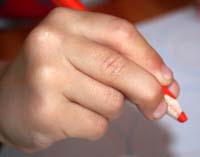

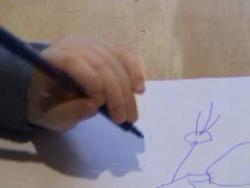
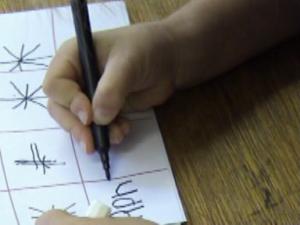
Does using a pencil grip help?
More about pencil grasp and finger movements
A good pencil grasp pattern allows the child to hold the pencil in the hand in such a way that small movements of the fingers and wrist can be used to move the pencil point in all directions on the paper.
The three finger tripod grasp the most common configuration: the pencil is stabilised between the thumb and the side of the index and middle fingers.
- The ring and middle fingers rest lightly in the palm of the hand.
- The wrist is held straight (in extension).
A good grasp allows the child to make small bending and straightening movements of the fingers.
;
In this short video you see how I use a combination of small finger movements, combined with small wrist movements to draw short lines in different directions. TIP: Click on the gear to for slow motion playback.
The position of the thumb varies
Some children adopt a typical tripod grasp with the thumb held away from the index finger with a gap between the thumb and index finger.
The thumb may also be held close to the index finger (thumb adduction). This position is commonly seen in children with hypermobile fingers. (More about thumb position)


Grasps that are not functional
A pencil grasp is not functional if it does not allow the child to easily make small bending and straightening (flexion and extension) movements of the fingers to manipulate the pencil point on the paper.
A tight tripod grasp
A tripod grasp where the pencil is held very tightly with the index and middle finger strongly flexed at the first middle finger joint and over extended at the end finger joint does not allow for easy small movements of the fingers.
Straight finger grip with index finger resting on top of the pencil shaft
In this grip configuration the pencil with the middle finger resting on top of the pencil shaft. The index and middle fingers straight (extended).
In the picture below the pencil is stabilised between the pads of the thumb and fingers.

Four finger grip
Some children hold the pencil with all the fingers resting on the pencil. This position does not allow easy finger movements.
Teachers and therapists often recommend that a child adopt a dynamic tripod grip with a gap between the thumb and the pencil shaft.
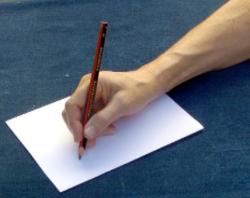
Although many children will spontaneously adopt this position, it does not work for every child, and especially not for a child with hypermobile finger joints. Holding the thumb close to the shaft of the pencil seems to work best for these children. This type of grip is sometimes referred to as a thumb wrap grip.

The role of the thumb in creating an effective pencil grip
The fingers and thumb are positioned on the pencil shaft to provide two different functions: stability and mobility.
- Flexion and extension movements of the fingers provide the mobility function.
- The stability function is provided by gripping the pencil between the thumb and the side of the middle finger. This can be done in different ways with the thumb in different positions.
Thumb stabilization in a dynamic tripod grasp pattern
In a tripod grip the thumb is positioned with a gap between the thumb and the forefinger. To achieve this position the thumb must be abducted.
The pencil is held between the pad of the thumb and the side of the forefinger.

The shaft of the pencil rests in the corner of the thumb web space or against the side of the forefinger.
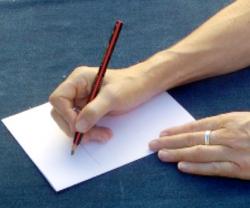

The thumb adduction grasp
In a thumb wrap grasp the pencil shaft is stabilised between the thumb and and the side of the forefinger and the middle finger.
The thumb is held close to the forefinger - the thumb is adducted.
Holding the thumb in adduction provides stability, especially for a child who has hypermobile thumb joints.
An adducted thumb position is effective if it allows small movements of the fingers to move the pencil tip.

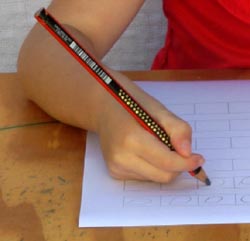
The thumb does not play an active role in moving the pencil tip
In a conventional tripod grip with the thumb in abduction the thumb joints do move. This movement happens in response to the changing position of the fingers as they flex and extend.
This is an important point because it underscores the role of the thumb in pencil grip. The thumb provides stability and this can be done with the thumb in a number of different positions as long as the grip as a whole allows for easy finger movements.
More about pencil grip and finger movements
What is an effective pencil grip?
Thumb position for an effective grip
How to assess your child's pencil grip and finger movements
How to change an ineffective grip
Training finger movements for handwriting
Handwriting Gym Online Handbook
SfA Therapist Resources & HWG Handbook
Bibliography
Schwellnus H, Carnahan H, Kushki A, Polatajko H, Missiuna C, Chau T. Effect of pencil grasp on the speed and legibility of handwriting in children. Am J Occup
Ther. 2012 Nov-Dec;66(6):718-26.
Pencil grasps other than the dynamic tripod may be functional for handwriting. This study examined the impact of grasp on handwriting speed and legibility.
We videotaped 120 typically developing fourth-grade students while they performed a writing task. We categorized the grasps they used and evaluated their writing for speed and legibility using a handwriting assessment. Using linear regression analysis, we examined the relationship between grasp and handwriting.
We documented six categories of pencil grasp: four mature grasp patterns, one immature grasp pattern, and one alternating grasp pattern. Multiple linear regression results revealed no significant effect for mature grasp on either legibility or speed.
Pencil grasp patterns did not influence handwriting speed or legibility in this sample of typically developing children. This finding adds to the mounting body of evidence that alternative grasps may be acceptable for fast and legible handwriting.
Schwellnus H, Carnahan H, Kushki A, Polatajko H, Missiuna C, Chau T. Effect of pencil grasp on the speed and legibility of handwriting after a 10-minute copy task in Grade 4 children. Aust Occup Ther J. 2012 Jun;59(3):180-7. doi: 10.1111/j.1440-1630.2012.01014.x. PubMed PMID: 22690768.
Abstract
To investigate the impact of common pencil grasp patterns on the speed and legibility of handwriting after a 10-minute copy task, intended to induce muscle fatigue, in typically developing children and in those non-proficient in handwriting.
A total of 120 Grade 4 students completed a standardised handwriting assessment before and after a 10-minute copy task. The students indicated the perceived difficulty of the handwriting task at baseline and after 10 minutes. The students also completed a self-report questionnaire regarding their handwriting proficiency upon completion.
The majority of the students rated higher effort after the 10-minute copy task than at baseline (rank sum: P = 0.00001). The effort ratings were similar for the different grasp patterns (multiple linear regression: F = 0.37, P = 0.895). For both typically developing children and those with handwriting issues, the legibility of the writing samples decreased after the 10-minute copy task but the speed of writing increased. CONCLUSIONS AND SIGNIFICANCE OF THE STUDY: The quality of the handwriting decreased after the 10-minute copy task; however, there was no difference in the quality or speed scores among the different pencil grasps before and after the copy task. The dynamic tripod pencil grasp did not offer any advantage over the lateral tripod or the dynamic or lateral quadrupod pencil grasps in terms of quality of handwriting after a 10-minute copy task. These four pencil grasp patterns performed equivalently. Our findings question the practice of having students adopt the dynamic tripod pencil grasp.
